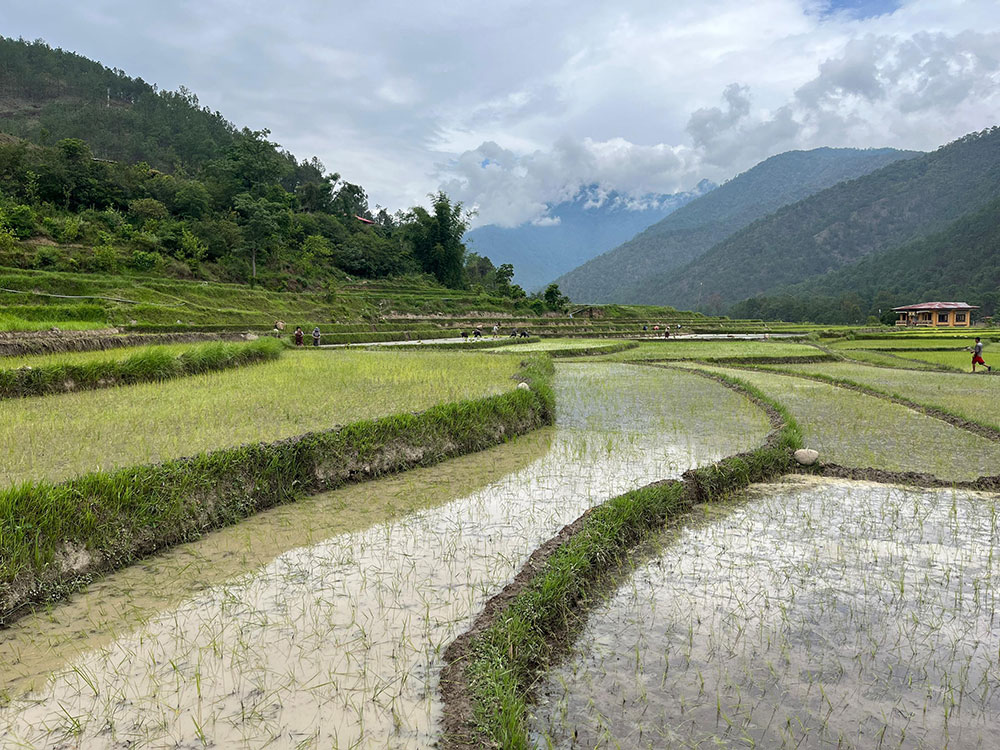Chencho Dema
Punakha—He gazes across his fields with a blank expression. His neighbours are hard at work transplanting paddy saplings in their barely flooded fields. He is not sure. Without enough water, his saplings wouldn’t survive. That’s why, he stands and waits.
Chimi Dorji, a 20-year-old farmer from Ritsa village in Guma Gewog, Punakha, waits for either water or rain. Water is already scarce, and rain is yet to arrive. He stands and waits but for how long? The paddy transplantation season is here once again but without water or rain.
The overgrown saplings are beginning to wither under the scorching sun. The lack of rain has left the farmers of Ritsa grappling with the water crisis.
Each year, during the paddy transplantation season, the farmers of Punakha, often hailed as the rice bowl of Bhutan, confront severe irrigation water shortages. In particular, the farmers of Dochu-Ritsa and Changyul-Tashijong chiwogs in Guma find themselves confronting the crisis every year.
Guma Gewog comprises 445 households and covers 35.12 acres of paddy fields and 21.23 acres of dry land. Thanks to the lack of irrigation water, the gewog has laid 35.13 acres of land fallow.
Although young, Chimi Dorji talks with the gravity of a seasoned farmer. He says last year’s delay in transplanting paddy resulted in a poor harvest. He fears a similar fate this year.
“As farmers, this is our annual food,” he says. “How are we going to survive if the situation keeps deteriorating? If the water problem cannot be resolved, the government should at least permit us to convert our paddy fields into dry land.”
Other farmers share Chimi Dorji’s concern and raised questions about when their longstanding water crisis would be addressed.
Kezang Namgay, a 34-year-old farmer of Changyul, said that governments and MPs have come and gone, but the water problem in his village has remained unresolved.
“We have consistently raised this issue, but it seems to fall on deaf ears,” he said. “Apart from hiring water pumps, which is expensive, there’s little we can do.”
He said that those with land near the Mochu and at higher elevations can cultivate their fields, but for farmers like him, whose land is in between, the situation is particularly challenging.
As a temporary solution, the two chiwogs have been pumping water from the Mochu, which incurs significant expenses. While the Farm Machinery Corporation supplies water pumps, the farmers bear the fuel cost, which they find expensive.
Talking to Kuensel, Namgay Bidha, the Changyul Tshogpa, said that the farmers had consistently voiced concerns about the annual water shortage. Yet, there is little they can do except depend on the river. Last year, some farmers even left their fields fallow because of the water scarcity.
Changyul has 360 acres of paddy fields.
Gaylong, the deputy chief agriculture officer (DCAO), acknowledges that the two villages of Guma experience a severe shortage of irrigation water compared to other villages in the dzongkhag.
Last year, large swathes of paddy fields were left fallow due to the lack of water. This year, the situation has worsened with the drying up of the primary water source at Nakulum. Farmers relied on this water source for paddy cultivation.
For farmers, it’s water or rain. They expect an early monsoon, failing which, the situation will deteriorate. Without timely rain, they will have to pin their hope on water pumps. The situation is dire as expenses have significantly surpassed the income they expect to generate from crop yields.
Last year, the dzongkhag provided water pumps on a cost-sharing basis. The government bore 60 percent of the cost and farmers, 40 percent. “This year, we are requesting the government to bear 70% of the cost,” the tshogpa said.
The situation has deteriorated every year, prompting the dzongkhag to consider two solutions.
The DCAO said the first is to build a large water pump capable of drawing water from the Mochu over three kilometres. However, this solution is short-term, seasonal, and unreliable. So, it has been discarded. The second plan is to construct an irrigation canal in Kabji as a long-term project. A survey for this project will be conducted soon.
Meanwhile, Khawajara village, Toewang Gewog, and Bali chiwog in Chubu Gewog have also reported irrigation water shortages.
In 2021, the Bajo Agriculture Research and Development Centre installed a 20-kilowatt Khawajara solar water pump with technical support from the UNDP and funding from the Green Climate Fund Project. It was designed to provide additional irrigation water supply to the people of Khawajara in Toewang Gewog.
However, the machine is said to have been damaged resulting in irrigation water shortage. The DCAO said that the repaired machine would soon arrive and the problem would be solved.
Almost all varieties of crops can be grown in Guma Gewog, but the farmers grow rice is the primary crop.
Even during the chilli planting season, the farmers have to resort to water from the Mochu. This highlights the severity of the water shortage.
Records with the dzongkhag agriculture sector show that over 1,455 acres of land, both paddy fields and dry land, have been laid fallow across the 11 gewogs of the dzongkhag.
The gewogs include Baarp, Chubu, Dzomi, Goenshari, Guma, Kabjisa, Lingmukha, Shengana, Talo, Toepisa, and Toedwang.
The Punakha region boasts 8,373.2785 acres of paddy fields and 2,347.423 acres of dry land. Of that, 7,457.686 acres of paddy fields and 1,732.472 acres of dry land remain uncultivated.


